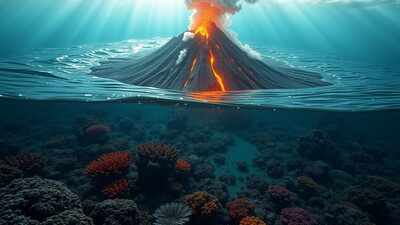
This is an AI-generated image, used for representational purposes only.
A
n underwater volcano roughly 300 miles off the Oregon coast is rumbling back to life, with scientists warning that an eruption could take place any time before the end of the year.
Known asAxial Seamount, the volcano lies nearly a mile beneath the ocean’s surface and has been showing clear signs of activity in recent weeks.As per NBC News, researchers recorded over 1,000 earthquakes per day in late March and early April. Bill Chadwick, a volcanologist at Oregon State University who has studied Axial for three decades, said, “The seafloor is actually rising, and that’s a big signal.” This swelling indicates magma is accumulating beneath the structure, a known precursor to eruption.
The volcano, located on both a geological hot spot and the tectonic boundary between the Pacific and Juan de Fuca plates, is being closely monitored through a network of seafloor sensors. According to CNN, the region is a hotbed of volcanic activity due to the plates constantly pulling apart, which fuels pressure buildup and magma flow.Despite the intense activity, scientists say there is little threat to human life.
“Even if you were out on a boat right over the seamount when it’s erupting, you probably would never know it,” Chadwick was quoted as saying by NBC News. The volcano’s remote location and depth make it unlikely to impact coastal communities or marine traffic.William Wilcock, a marine geophysicist at the University of Washington, was quoted as saying by CNN, “I would say it was going to erupt sometime later this year or early 2026, but it could be tomorrow, because it’s completely unpredictable.”Axial Seamount previously erupted in 1998, 2011, and 2015. During its last eruption, magma spilled across 25 miles of seafloor, with some lava flows reaching 450 feet thick, about two-thirds the height of Seattle’s Space Needle, NBC News reported.The volcano’s caldera, formed from earlier collapses of its magma chamber, is also a hub of deep-sea life. Streams of mineral-rich fluid, or “snowblowers,” emerge from hydrothermal vents, sustaining ecosystems that bounce back within months even after lava flows destroy them.While eruption prediction remains challenging, Axial Seamount offers a rare natural lab for improving forecasting models. “We don’t have to worry about the human cost if we’re wrong,” said Scott Nooner of the University of North Carolina Wilmington, adding that this makes it ideal for testing predictions.Interestingly, researchers have also noticed a seasonal pattern: all three past eruptions occurred between January and April, a period when the Earth moves away from the sun. Gravitational forces from the moon may affect the timing, as ocean tides apply fluctuating pressure to the volcano’s structure.Debbie Kelley, director of the Regional Cabled Array, was quoted as saying by CNN that the observatory hopes to livestream the next eruption, marking a scientific first in seafloor volcanology.While the eruption may remain unseen from land, scientists say it will offer invaluable insights into how the Earth builds itself from below, without the danger that often accompanies eruptions on land.

 1 month ago
60
1 month ago
60




























 English (US)
English (US)